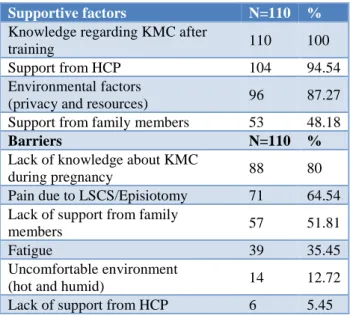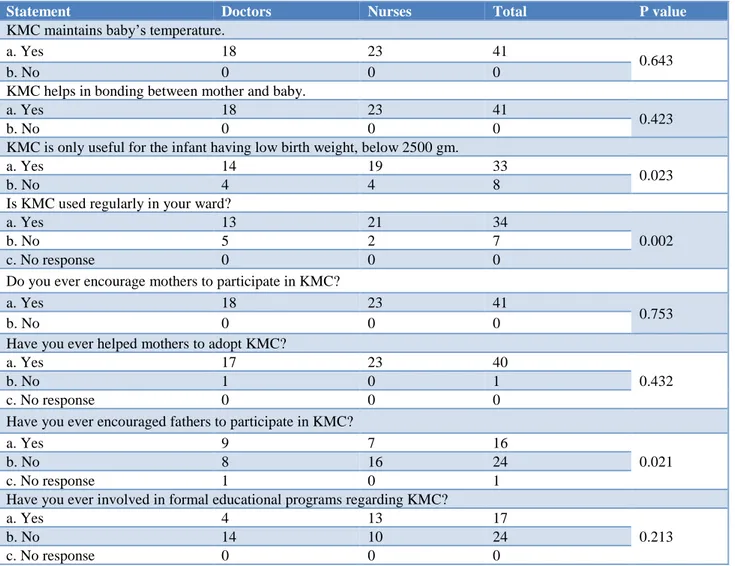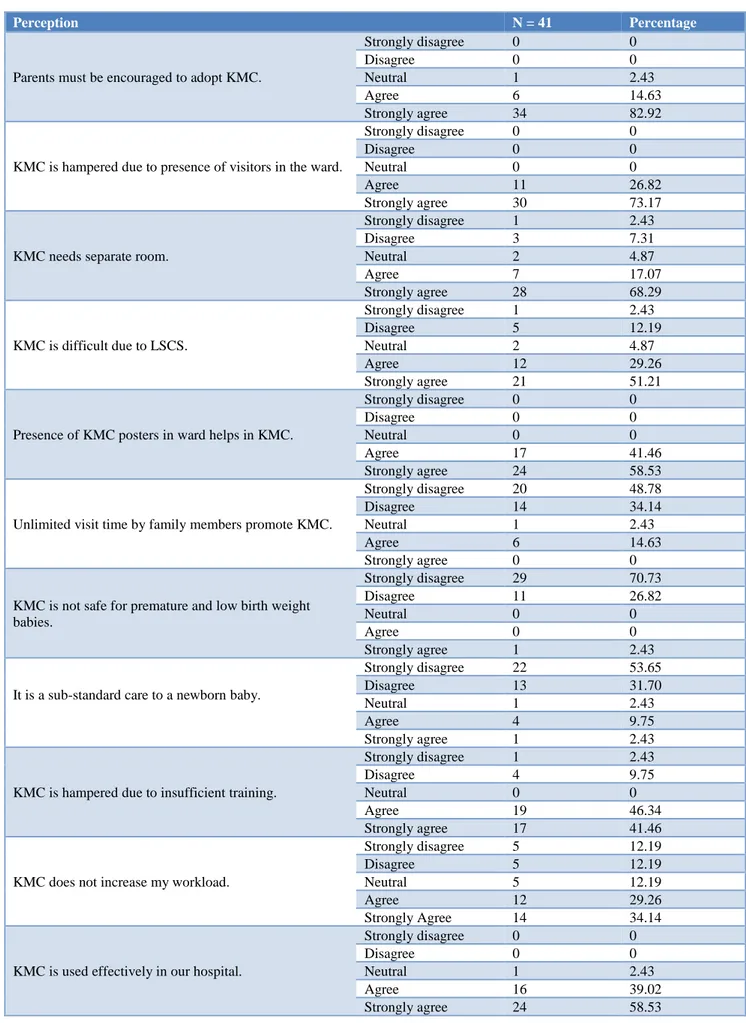Original Research Article
Kangaroo mother care for low birth weight babies: supportive factors
and barriers
Dinesh Mekle, Amit Kumar Singh*, Jagdamba Dixit
INTRODUCTION
Low Birth Weight (LBW) babies still remains a major public health problem in developing countries like India.1
LBW babies have 8 times higher perinatal mortality in comparison to babies with normal birth weight.2
Kangaroo Mother Care (KMC) means keeping a LBW baby on the mother’s bare chest between both the breasts, in prone position, which keeps the baby warm and increases accessibility to breast feeding, protects the baby from infections and provide stimulation to baby. In short,
the mother acts as an incubator, where the mother and baby are not separated for long time.3,4 KMC was first
developed by Dr. Edgar Rey and Dr. Hector Martinez in 1978 in Bogotá, Columbia in an attempt to increase the survival of stable LBW infants in resource poor countries.5 KMC facilitates breastfeeding, makes the
mother more confident about caring her infant, and it results in early hospital discharge.6 KMC is proven to
decrease the mortality rate among premature infants and it is accepted and feasible method worldwide.7 There is
very less literature available regarding the KMC
ABSTRACT
Background: Kangaroo mother care (KMC) is skin-to-skin contact between mother and low birth weight (LBW) baby. It keeps the baby warm, increases accessibility to breast feeding, and protects the baby from infections. This study was done to identify supportive factors and barriers in practicing KMC as perceived by mothers of LBW babies and health care personnel (HCP).
Methods: It was a questionnaire based descriptive study. Mothers of LBW babies and HCP were enrolled in study. Mothers and HCP were sensitized regarding KMC and after practicing KMC for 3 days, mothers were interviewed with the help of a predefined proforma. Feedback from the HCP was also taken. Data analysis was performed by using IBM SPSS ver. 20 software.
Results: Most common factor in initiation and practice of KMC were, knowledge regarding KMC after training (100%), environmental factors (privacy and resources) (87.27%) and support from HCP (94.54%). Most common barriers perceived during performance of KMC were lack of knowledge about KMC during pregnancy (80%), pain due to LSCS/episiotomy (64.54%) and lack of support from family members (51.81%). Majority of the HCP strongly agree that parents must be encouraged to adopt KMC (82.92%), KMC is hampered due to presence of visitors in the ward (73.17%). KMC needs separate room (68.29%) and it is difficult due to LSCS (51.21%).
Conclusions: To increase KMC practice, mother’s knowledge about KMC can be improved by educating them in antenatal clinics and all HCP should receive training on KMC.
Keywords: Barriers, HCP, KMC, LBW, Supportive factors
Department ofPediatrics, Peoples College of Medical Sciences and Research Centre, Bhopal, Madhya Pradesh, India
Received: 27 March 2019
Accepted: 2 May 2019
*Correspondence:
Dr. Amit Kumar Singh,
E-mail: dramitsingh58@gmail.com
Copyright: © the author(s), publisher and licensee Medip Academy. This is an open-access article distributed under the terms of the Creative Commons Attribution Non-Commercial License, which permits unrestricted non-commercial use, distribution, and reproduction in any medium, provided the original work is properly cited.
promotion in our country and more so in Madhya Pradesh. Hence, this study was done at tertiary care teaching hospital to inspect the views regarding the acceptability and feasibility of implementation and practicing of KMC and to determine supportive factors and barriers perceived by mothers and Health Care Personnel (HCP).
METHODS
This was a questionnaire based descriptive study that was conducted in the department of Pediatrics of a teaching hospital in central Indiaduring January 2017-April 2018.
Inclusion criteria
Mothers of LBW babies who required admission in Neonatal Intensive Care Unit (NICU) or step down nursery and HCP (residents of Pediatrics, Obstetrics and Gynaecology and nursing staff working in NICU, step down nursery and post-natal ward).
Exclusion criteria
Mothers of newborn babies weighing >2.5 kg, if mother or baby died, or went LAMA before completing the study, mothers not giving consent for the study.
The study was approved by the Institutional Ethics Committee. Mothers were enrolled in the study after taking the written informed consent once the baby was fit for KMC. After the mother was enrolled in study, she was sensitized for KMC about method and advantages with the help of a mannequin, flip chart, videos, posters and role play. Two teaching sessions were arranged per week for sensitization of mothers regarding KMC.
Mothers were also provided a separate room for privacy, separate KMC coat and KMC chair to facilitate the KMC in existing set up. After she practiced KMC for 3 days, she was interviewed with the help of a predefined proforma having both open and close ended questions with their demographic details. A mini workshop was organised to sensitize the HCP regarding KMC with the help of flip charts, model, video demonstration, and role play and their queries were addressed. Feedback from the HCP was taken by the end of the study or if someone left in between, he/she was asked to give feedback before leaving. Questionnaire was in native language, which was validated by the subject expert.
All the data analysis was performed using IBM SPSS version 20 software.
RESULTS
Total 110 mothers and 41 HCP were included in the study. Majority of the mother were between 21-25 years
belonged to nuclear family (60.90%), had income of <5000 per month (59.09%) and belonged to urban area (71.81%).
Table 1: Supportive factors and barriers of KMC.
Supportive factors N=110 %
Knowledge regarding KMC after
training 110 100
Support from HCP 104 94.54 Environmental factors
(privacy and resources) 96 87.27 Support from family members 53 48.18
Barriers N=110 %
Lack of knowledge about KMC
during pregnancy 88 80 Pain due to LSCS/Episiotomy 71 64.54 Lack of support from family
members 57 51.81
Fatigue 39 35.45
Uncomfortable environment
(hot and humid) 14 12.72 Lack of support from HCP 6 5.45
Table 2: Perception of mother for KMC.
Perception N=110 %
Mother felt good after doing KMC
Strongly disagree 0 0 Disagree 1 0.90 Neutral 1 0.90 Agree 10 9.09 Strongly agree 98 89.09
Mother’s workload is increased due to KMC
Strongly disagree 79 71.81 Disagree 18 16.36 Neutral 6 5.45 Agree 7 6.36 Strongly agree 0 0
Pre-training enhances knowledge of KMC
Strongly disagree 0 0 Disagree 0 0 Neutral 0 0 Agree 14 12.72 Strongly agree 96 87.27
KMC enhances breast milk production
Strongly disagree 0 0 Disagree 0 0 Neutral 3 2.72 Agree 30 27.27 Strongly agree 77 70
Mother felt that KMC can cause injury to the baby
Strongly disagree 91 82.72 Disagree 19 17.27 Neutral 0 0 Agree 0 0 Strongly agree 0 0 Mothers felt that
KMC can cause injury to their stitches
In present study 41 HCP (18=doctors, 23=nurses) participated in study with mean age of respondents being 28.63 years and majority of them were females (87.80%).
Majority of the newborn babies had weight >2000 gm (73.5%), were born between 35-37 weeks of gestational age (57.3%) and were male (51.3%).
Most common factor in initiation of KMC was knowledge regarding KMC after training (100%), environmental factors (privacy and resources) (87.27%), support from HCP (94.54%) and support from family members (48.18%).
Most common barrier perceived during performance of KMC was lack of knowledge about KMC during pregnancy (80%) followed by Pain due to LSCS / episiotomy (64.54%), Lack of support from family members (51.81%), fatigue (35.45%) and uncomfortable environment (12.72%) (Table 1).
Majority of the Mother strongly agree that they felt good after doing KMC (89.09%), there was an enhancement of the knowledge of KMC after training (87.27%) and more milk has started to come after doing KMC (70%).
Most of the mothers strongly disagree that their workload is increased due to KMC (71.81%), KMC can cause injury to the baby (82.72%) and injury to their stitches (LSCS/episiotomy) (Table 2).
Majority of the HCP believed that KMC maintains baby’s temperature (P=0.643), helps in bonding between mother and baby (P=0.423).
In present study we found that KMC was used regularly in the ward (P=0.002), majority of the respondent encouraged mothers to participate in KMC (P=0.753) and helped them to adopt KMC (P=0.432). The important finding of present study was that HCP never encouraged fathers to participate in KMC (p-0.021) (Table 3).
Table 3: Knowledge and practice about KMC among the HCP.
Statement Doctors Nurses Total P value
KMC maintains baby’s temperature.
a. Yes 18 23 41
0.643
b. No 0 0 0
KMC helps in bonding between mother and baby.
a. Yes 18 23 41
0.423
b. No 0 0 0
KMC is only useful for the infant having low birth weight, below 2500 gm.
a. Yes 14 19 33
0.023
b. No 4 4 8
Is KMC used regularly in your ward?
a. Yes 13 21 34
0.002
b. No 5 2 7
c. No response 0 0 0
Do you ever encourage mothers to participate in KMC?
a. Yes 18 23 41
0.753
b. No 0 0 0
Have you ever helped mothers to adopt KMC?
a. Yes 17 23 40
0.432
b. No 1 0 1
c. No response 0 0 0
Have you ever encouraged fathers to participate in KMC?
a. Yes 9 7 16
0.021
b. No 8 16 24
c. No response 1 0 1
Have you ever involved in formal educational programs regarding KMC?
a. Yes 4 13 17
0.213
b. No 14 10 24
Table 4: Perception of healthcare personnel’s for KMC.
Perception N = 41 Percentage
Parents must be encouraged to adopt KMC.
Strongly disagree 0 0
Disagree 0 0
Neutral 1 2.43
Agree 6 14.63
Strongly agree 34 82.92
KMC is hampered due to presence of visitors in the ward.
Strongly disagree 0 0
Disagree 0 0
Neutral 0 0
Agree 11 26.82
Strongly agree 30 73.17
KMC needs separate room.
Strongly disagree 1 2.43
Disagree 3 7.31
Neutral 2 4.87
Agree 7 17.07
Strongly agree 28 68.29
KMC is difficult due to LSCS.
Strongly disagree 1 2.43 Disagree 5 12.19
Neutral 2 4.87
Agree 12 29.26
Strongly agree 21 51.21
Presence of KMC posters in ward helps in KMC.
Strongly disagree 0 0
Disagree 0 0
Neutral 0 0
Agree 17 41.46
Strongly agree 24 58.53
Unlimited visit time by family members promote KMC.
Strongly disagree 20 48.78 Disagree 14 34.14
Neutral 1 2.43
Agree 6 14.63
Strongly agree 0 0
KMC is not safe for premature and low birth weight babies.
Strongly disagree 29 70.73 Disagree 11 26.82
Neutral 0 0
Agree 0 0
Strongly agree 1 2.43
It is a sub-standard care to a newborn baby.
Strongly disagree 22 53.65 Disagree 13 31.70
Neutral 1 2.43
Agree 4 9.75
Strongly agree 1 2.43
KMC is hampered due to insufficient training.
Strongly disagree 1 2.43
Disagree 4 9.75
Neutral 0 0
Agree 19 46.34
Strongly agree 17 41.46
KMC does not increase my workload.
Strongly disagree 5 12.19 Disagree 5 12.19
Neutral 5 12.19
Agree 12 29.26
Strongly Agree 14 34.14
KMC is used effectively in our hospital.
Strongly disagree 0 0
Disagree 0 0
DISCUSSION
In present study, most important barriers that might restrict mothers using KMC were absence of information regarding KMC during pregnancy (80%), pain due to LSCS / episiotomy (64.54%), lack of support from family members (51.81%), fatigue (35.45%) and uncomfortable environment (Hot and Humid) (12.72%). These findings were comparable to study done by Solomon et al, that revealed 83.30% mothers were not educated and counselled about KMC in antenatal clinics.8
In this study the factors promoting KMC were improved knowledge regarding KMC after training (100%), support from HCP (94.54%), privacy and resources (87.27%) and support from family members (48.18%). A study conducted by Seidman et al where participating mothers had realized the importance of KMC and its benefits to the infants and main enablers to KMC practice for mothers were mother- infant attachment, support from family, friends and HCP and positive elements of the facility like privacy and resources.9
In present study KMC mothers strongly disagree that KMC can cause injury to the baby (82.72%), KMC can cause injury to their stitches (LSCS/episiotomy) (72.72%), their workload is increased due to KMC (71.81%), and strongly agree that mothers feel good after KMC (89.09%), there is an enhancement of the knowledge of KMC after training (87.27%), more milk has started to come after doing KMC (70%). In agreement to present study Solomons et al, in a similar study reported that the 96.6% mothers felt positive towards KMC, about 83.3% received adequate information and support about KMC from HCP and 66.7% mothers respond that there is improved breast feeding after KMC.8
In present study, majority of the HCP believed that KMC maintains child’s temperature, helps in bonding between mother and baby and found useful for LBW babies. In this study KMC was used regularly in the NICU and step down nursery and was applied every day in the ward for care of the babies. We also found that HCP gave information about KMC to the parents, encouraged mothers to participate in KMC, and helped them to adopt KMC. However, in present study we found that HCP did not encouraged fathers to participate (P=0.021) and practice KMC (P=0.002). Shah et al, studied knowledge, attitude and practice of kangaroo mother care among health workers in tertiary health center in Nepal and concluded that parents must be encouraged to adopt KMC, and KMC is hampered due to presence of visitors in the ward.10
Nirmala et al, conducted a study for assessment of role of father in KMC, which concluded that most of the fathers were not interested in the practice of KMC. It is mostly contributed to the cultural practice which shows that
mother is the only responsible for nursing needs of the baby.11 The fathers mostly see themselves as the support
to mother who is giving KMC. However, the fathers who got more involved in practicing KMC have felt more confident about handling their babies and they get more involved in babies nursing care.12
The nursing staffs who were involved in intensive neonate care units should be trained in KMC so that they can train mothers to provide it safely and effectively.13
Most of the HCP believed that parents must be encouraged to adopt KMC, it is difficult due to LSCS, KMC is hampered due to presence of visitors in the ward and they further believed that unlimited visit time by family members do not promote KMC. Conversely, in the study of Eichel P et al and De Vonderweid et al, concluded that few HCP are of a view that mothers doing KMC, needs constant family support for practicing KMC. So according to them long visiting hours in hospital will facilitate KMC rather than hindering it.14,15
In present study majority of HCP believed that KMC is safe for premature and LBW babies and they are of the opinion that KMC does not increase their workload.
Contrary to that in a study by Charpak N et al, concluded that medical professionals consider KMC as substandard care and it unnecessarily increases their workload and this has led to inadequate implementation and continuation of KMC in developing countries.4
The present study has the few limitations like questionnaire based descriptive nature of the study and small sample size. A large randomized clinical trial is required to strengthen the present study findings.
Funding: No funding sources Conflict of interest: None declared
Ethical approval: The study was approved by the Institutional Ethics Committee
REFERENCES
1. Nguah SB, Priscilla NL Wobil, Regina O, Ayi Y, Kerber KJ, Joy E. Lawn and Low birth weight. A tabulation of available information. Geneva, World Health Organization; 1992.
2. Gogoi N. Maternal and neonatal risk factors of low birth weight in Guwahati Metro, Assam, Northeast India. Acad J Ped Neonatol. 2018;6(5):1-6.
3. Pattinson R, Woods D, Greenfield D, Velaphi S. Improving survival rates of newborn infants in South Africa. Reprod Heal. 2005;2(1):1-8.
4. Charpak N, Ruiz JG, Zupan J, Cattaneo A, Figueroa Z, Tessier R, et al. Kangaroo mother care: 25 years after. Acta Paedia. 2005;94(5):514-22.
6. Roberts KL, Paynter C, McEwan B. A comparison of kangaroo mother care and conventional cuddling care. Neonatal Netw. 2000;19(4):31-5.
7. Hall D, Kirsten G. Kangaroo mother care- a review. Transfus Med.2008;18(2):77-82.
8. Solomons N, Rosant C. Knowledge and attitudes of nursing staff and mothers towards kangaroo mother care in the eastern sub-district of Cape Town. S Afr J Clin Nutr. 2012;25(1):33-9.
9. Seidman G, Unnikrishnan S, Kenny E, Myslinki S, Smith CS, Mulligan B, et al. Barriers and enablers of kangaroo m other care practice: a systematic review. PLoS One. 2015;10(5):e0125643.
10. Shah RK, Sainju NK, Joshi SK. Knowledge, attitude and practice towards kangaroo mother care. J Nepal Heal Res Council. 2018;15(3):275-81.
11. Nirmala P, Rekha S, Washington M. Kangaroo mother care: effect and perception of mothers and health personnel. J Neonatal Nurs. 2006;12(5):177-84.
12. Johnson AN. The maternal experience of kangaroo holding. J Obstet Gynecol Neonatal Nurs. 2007;36(6):568-73.
13. Engler AJ, Ludington-Hoe SM, Cusson RM, Adams R, Bahnsen M, Brumbaugh E, et al. Kangaroo care: national survey of practice, knowledge, barriers, and perceptions. MCN Am J Maternal/Child Nurs. 2002;27(3):146-53.
14. Eichel P. Kangaroo care: expanding our practice to critically ill neonates. Newborn Infant Nurs Rev. 2001;1(4):224-8.
15. Vonderweid U, Forleo V, Petrina D, Sanesi C, Fertz C, Leonessa ML, et al. Neonatal developmental care in Italian Neonatal Intensive Care Units. Ital J Pediatr. 2003;29(3):199-205.


